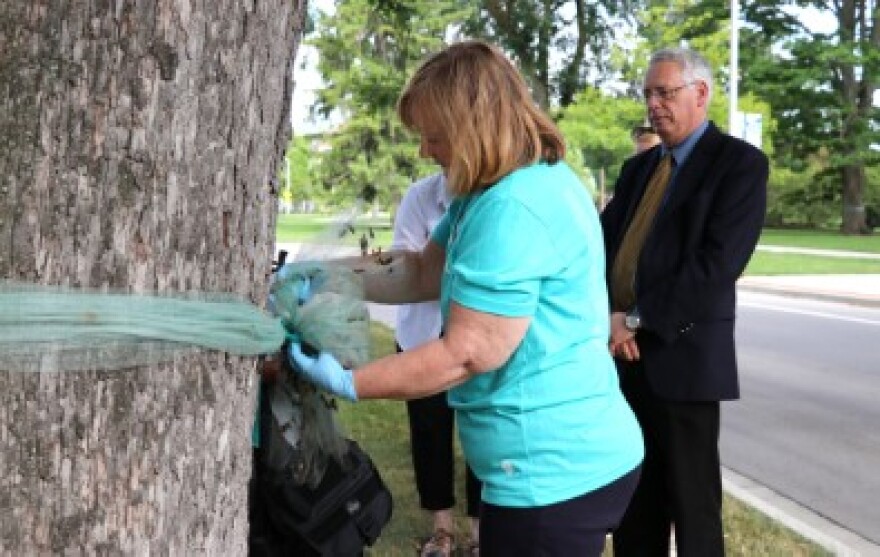The hundreds of women who say they were sexually assaulted under the guise of treatment by disgraced former MSU doctor Larry Nassar will be remembered in a new exhibit at Michigan State University.
Editor's Note: During our airing of this story on Current State last weekend, we incorrectly identified the MSU Museum as the MSU Public Museum. We apologize for the error.
The teal bows tied on trees around campus this past winter as a reminder of the survivors will be on display at the MSU Museum according to museum leaders.

It is late morning on a sunny, breezy day when Valerie von Frank takes us for a walk near the Hannah Administration Building on Michigan State University’s campus.
As if they are her personal friends, von Frank introduces us to many of the tall, leafy trees along the way
She knows them by name and by heart.
“Melody is a different type of tree than Grace’s tree but they are side by side because Melody and Grace were side by side for so many years,” von Frank said. “Jessica Smith is nearby as well.”
To understand why von Frank named more than 200 trees on campus we must rewind to winter this year. That’s when hundreds of ribbons, added a pop of teal – the color of sexual assault awareness - to campus during a dreary winter. von Frank says she attached a ribbon with a name or number to trees in specific areas across campus.
“It was important that every survivor, that every girl, had a place and a reminder a visual reminder that she was not just a survivor but she had a name and place where you could see that name,” she said.

Names like Jessica Smith. This is her victim impact statement read in Ingham County in January.
“I’m here to support all the amazing women and men to that have endured the trauma from the defendant. Because of Nassar, I struggle. I struggle to trust and feel comfortable. I struggle to sleep and be me. I struggle to stay sane and stable and most importantly I struggle to be myself,” Smith said.
That struggle may now be a part of the lives of the hundreds of women who have accused disgraced MSU sports doctor, Larry Nassar of sexual abuse, while he was treating them.
Judges in Eaton and Ingham counties sentenced Nassar to decades in prison after he pleaded guilty to criminal sexual conduct.
Also, Michigan State University agreed to a $500 million settlement to be shared among the hundreds of survivors – many of whom von Frank honored.
“I wanted something that was a tribute to the girls themselves. The trees are symbols of growth and renewal. I wanted something that captured the breadth of what had happened,” she said.
But the memorial was short lived. It wasn’t long until gypsy moths began laying eggs and producing larva in the ribbons. Eventually, new moths would start eating the leaves. Without leaves trees, lose their ability to photosynthesize according to scientists.
So, the bows had to come down, but how? von Frank worked with MSU Museum Director Mark Auslander to save the ribbons to house them in a future exhibit at the MSU Museum.
“Of course the most important witnesses were the human survivors that very bravely in their testimony showed extraordinary courage. But there’s another kind of witness and that’s the natural world and those are trees because they live so long and have seen so much of the best and worst of the history of this institution,” Auslander said.

Removing the bows was a spiritual ceremony.
“Only the mothers would touch the ribbons – that was the parents and the allies who put them up who really understood that the trees would be witnesses for all this terrible silence. They were the appropriate people to untie them so we wanted to support their right to be the ones to take them down,” Auslander said.
von Frank walks up to a tree next to a sidewalk leading to the administration building. She places both hands on the truck and breathes. This is her daughter Grace French’s tree.
“It was the hardest to put up and the hardest to come down,” von Frank said.
von Frank hopes in untying the ribbons the knots in the humans they represented were also eased.
“The unknotting was hard on some of the trees it was easier on some others. I think that’s like the survivors. For some, that knot is still very tight and we are still working on that release. And for others it’s been a little bit easier to adjust and to cope with so the untying of some trees was not quite as hard,” von Frank said.
But memories of the survivors remain in MSU’s silent witnesses and the story the trees told.
The exhibition showcasing the ribbons will open at the MSU Museum in April of next year. Survivors and their parents will co-curate the showing called, “Finding our Voice: Sister Survivors Speak,” according to museum leaders. Click on this sentence to learn more about the project.







